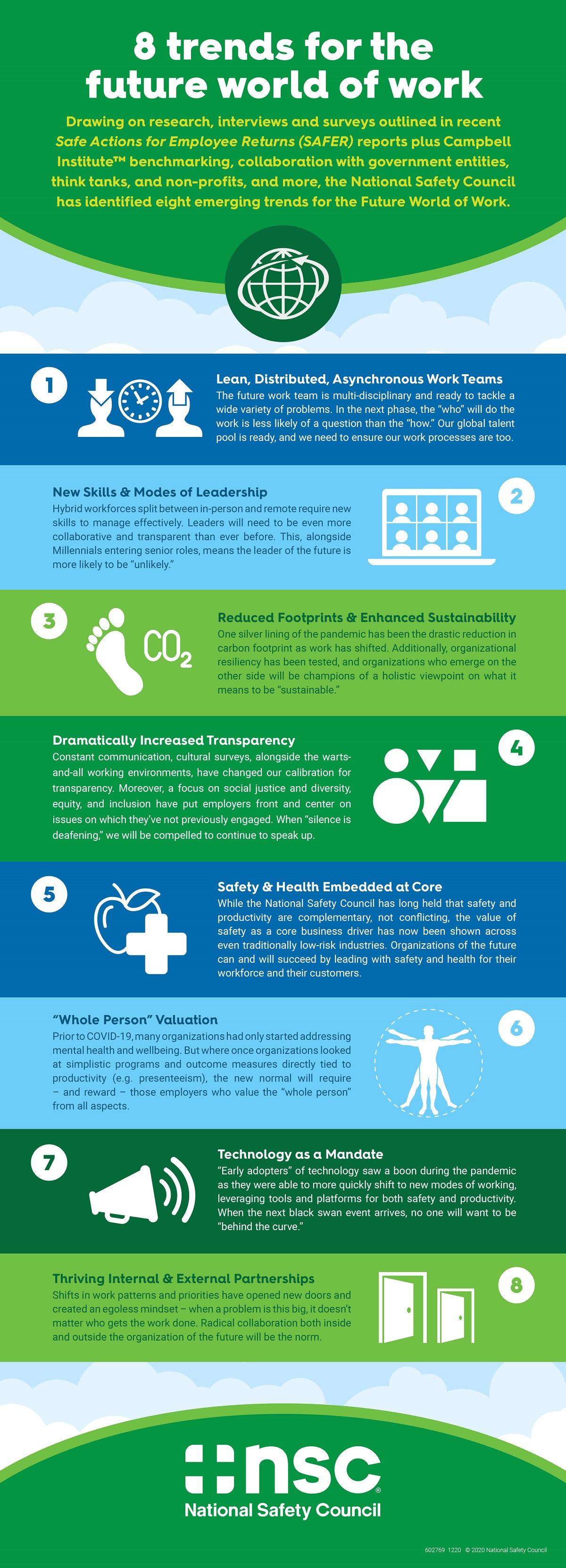SAFER guidance evolves as vaccine distribution continues
NSC-led initiative wants to help employers ‘understand the spectrum of what they can do’

As the push to get more people vaccinated against COVID-19 continues throughout the country, more employers are thinking about bringing employees back to the physical workplace. This means planning how to keep workers safe and healthy amid the pandemic.
“You don’t want to go back to the office and pretend as if it doesn’t exist,” said John Dony, senior director, thought leadership, at the National Safety Council and the council’s staff lead on SAFER: Safe Actions for Employee Returns – an initiative aimed at developing industry- and risk-specific resources and recommendations for employers. “You’re still going to need all the controls, from physical distancing to masks to redesign of work and everything in between, then assess your progress as you go.”
Since its inception last year, SAFER has been a real-time resource for organizations of all sizes that have brought workers back onsite or are considering it.
“If someone’s looking to us for guidance, it’s guidance that’s going to be in place tomorrow, and it’s going to save lives,” Dony said.
Latest resources
Most recently, the SAFER task force has been focused on providing guidance on COVID-19 vaccines.
A new vaccine framework is intended to help employers understand a wide variety of issues, such as policies, communication, efficacy of vaccines, distribution and the impact on various populations within their workforce.
“It lays out the issues to help you understand what’s out there,” Dony said.
Find the SAFER resources mentioned in this article at nsc.org/safer.
Additionally, the COVID-19 Vaccine Employer Question Guide includes a list of various questions employers should ask themselves about their vaccine policy, such as how vaccine availability impacts reopening plans, what COVID-19 policies should be maintained or modified, and how to communicate a vaccination plan.
Also available: the Spectrum of Employer Vaccine Approaches document, which provides a summary of approaches adopted by various organizations. Those approaches land on a spectrum from simply communicating fact-based information from reputable sources to mandating vaccination – with encouraging workers to get vaccinated and incentivizing vaccination through nondiscriminatory mechanisms falling in between.
Guidance on how to “best decide on an approach for your workplace” also is included in the resource.
“It’s not meant to be prescriptive,” Dony said of the guidance. “We want to help organizations understand the spectrum of what they can do and lay out the universe of possibilities so they see that there’s more they can potentially do, beyond what they’re already doing, and help them do that efficiently.”
Finding lessons
As more people get vaccinated and COVID-19 case numbers wane, Dony said the SAFER task force’s work will reflect that change.
Over the summer and fall, the task force – made up of nonprofit organizations, businesses, medical professionals, government agencies and trade associations – is expecting to take stock of what lessons have been learned from the pandemic’s impact on workplaces.
“We want to capture the good things that have happened as well as the bad,” Dony said. “The lessons learned, the successes, and really try to make sure that a year from now this doesn’t just become a book on the shelf. We really want to capitalize on the good that can come of this.”
Dony added that the work of the task force and its partner organizations can impact future planning in terms of infectious diseases, crisis management, crisis recovery and disasters.
“Our goal is not to get people back in the office to get people back in the office or their workplace,” he said. “It’s to understand how we can do our jobs safely and effectively. So, our guidance will continue to move in that direction.”
Looking to the future
As part of its work, the SAFER task force recently issued a report on the future world of work, based on more than 30 in-depth interviews with experts in safety, as well as medical and public health, from 13 different industries.
According to those experts, many employers have been more agile than previously believed and were able to use their pandemic response to break down internal silos.
The task force also developed an infographic that highlights eight future work trends:
- Lean, distributed, asynchronous work teams
- New skills and modes of leadership
- Reduced footprints and enhanced sustainability
- Dramatically increased transparency
- Safety and health embedded at core
- “Whole person” valuation
- Technology as a mandate
- Thriving internal and external partnerships
“For organizations thinking about radical redesign of the way they do work,” Dony said, “we want to be there with them, chart that journey and understand what it means long term.”
That includes organizations mandating worker vaccination or going to a 100% remote workforce.
“We want to understand that and research it too,” Dony said.
Post a comment to this article
Safety+Health welcomes comments that promote respectful dialogue. Please stay on topic. Comments that contain personal attacks, profanity or abusive language – or those aggressively promoting products or services – will be removed. We reserve the right to determine which comments violate our comment policy. (Anonymous comments are welcome; merely skip the “name” field in the comment box. An email address is required but will not be included with your comment.)


